Kalajoki, Province of Oulu 作者: 来源: 发布时间:2021-03-31
一、人口,面积
Kalajoki is a coastal town and municipality of Finland. It is located in the province of Oulu and is part of the Northern Ostrobothnia region. The town has a population of 12,393 (31 January 2019) and covers an area of 2,391.30 square kilometres (923.29 sq mi) of which 1,469.15 km2 (567.24 sq mi) is water. The population density is 13.44 inhabitants per square kilometre (34.8/sq mi). The municipality is unilingually Finnish. Kalajoki is a well-known tourist attraction place in Finland due to long sandy beaches (sea) and related activities.
At the end of 2017, Kalajoki had 12,516 inhabitants, of whom 9,272 lived in agglomerations, 2,935 in sparsely populated areas, and the coordinates of the place of residence of 309 inhabitants were unknown. The percentage of agglomeration in Kalajoki is 76.0%. The population of Kalajoki is divided into four different clusters.
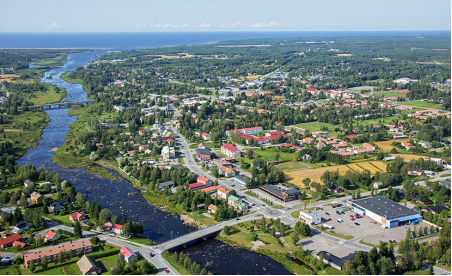
二、自然地理
1.地理条件
Kalajoki is a flat plateau in the north and a plateau in the south, divided by river beds. The bedrock is of varying rock species composition. In the northern and central part of the municipality there are mainly granite and granodiorite and in the southern part mica gneiss and migmatite. The bedrock of the Kalajoki River also contains small amounts of valuable minerals such as molybdenum. Here and there in the municipal area, especially on the coast, there are quarries, rocky terrain and rocky islands.
The most common soil types are moraine, peat and flood layers, as well as sand and sand from the coast. Kalajoki is famous for its extensive sandy beaches and dunes, the most notable of which are the almost 20-meter-high Tuomipakat. Vegetation-bound dunes are also abundant inland. In total, there are about 600 hectares of sand dunes on the banks of the Kalajoki River. The river valleys have flooded beach sand layers as well as clays. There are several bogs in the Kalajoki area. On the coast, the marshes are small, but inland they are wider. The largest bogs are Kaakkurinneva, Karhunmaanneva and Paloneva.
With the exception of the southern part, the coastline, which is constantly shaped by land uplift, is intact. As a result of land uplift, new land is exposed underwater, initially dominated by wetland vegetation. Especially on the north side of the Raumanjoki there are moist coastal meadows. The Rahja archipelago forms a unique landscape. In the middle of the open sea, a couple of miles from the shores of the Kalajoki River, the Kallankari rises. The land has a rock island of about two hectares, near which was once the most profitable fishing place in Ostrobothnia.

The municipality's most important waterways are the Kalajoki River and its tributaries Vääräjoki, Siiponjoki and the fresh-water Lestinjoki, which branches off in two at Saarenpää (the southern branch is Tomujoki) and joins the river Raumanjoki shortly before. Other rivers near the Kalajoki River are the Himanganjoki and the Pöntiönjoki. There are no lakes at all in the municipality, only small ponds.
2. 交通情况
The nearest airports are Oulu Airport (130 km) and Kokkola-Pietarsaari Airport (100 km).
The closest railway stations are located in Ylivieska (40 km) and Kokkola (70 km). From Kokkola railway station you can continue by bus to Kalajoki.
The closest ferry service is the Wasaline Umeå-Vaasa route. You can also reach Kalajoki by your private boat by docking at the Himanka (Sautinkari and Pikku-Mansikka), Rahja (Konikarvo), Hiekkasärkät, (Keskuskari), Kalajoki downtown (Ämmä) and Vasankari ports.
Distances to larger population centers along highways are: 130 km to Oulu (highway 8), Raahe 60 km (highway 8), Ylivieska 40 km (highway 27), 68 km to Kokkola (highway 8), and 548 kilometers to Helsinki.
三、经济发展和规模
Kalajoki has some industrial operations and a large tourism industry, as well as a working port due to its coastal location. The employment rate as of 2018 was 75.8 percent, and there was a total of 4,588 jobs in the area in 2017. The proportion of jobs by sector is: Primary production jobs 14.7%, processing jobs 31.8%, and Service jobs 51.7%.
Kalajoki’s Tax rate is 20%, it had an operating income of 22 million Euros in 2019, and ended with a surplus of 200,000 Euros in the budget at the end of 2019. The cities net investments for 2019 amounted to 7.6 million Euros.
The port operators for the Port of Kalajoki are Oy Blomberg Stevedoring Ab and Rahjan Huolinta – forwarding company. The overall traffic of the Port of Kalajoki is approximately 500,000 tonnes and there are about 150 vessels visiting the port annually. 70 percent of the traffic from the Port of Kalajoki is export. Sawn timber is the main export product of the port and every year 500,000 m3 is shipped from Kalajoki.
四、产业特点重点项目
Kalajoki is known mostly as a tourist destination due to its long sandy beaches, therefore it has a relatively large service and tourism industry. Besides the tourism and service industries, Kalajoki has its main industries in the forestry, metal, and wind turbine industries. Like the whole of Ostrobothnia region, Kalajoki is a forest-covered lowland. So, there is a lot of forest, and over time there have been several sawmills. Currently, the main sawmill is called Junnikkalan Saha.
Some of the main companies operating in Kalajoki in the metal industry are Kalajoki Diamond Drilling (Oy Kati Ab) which is a private company specializing in mineral exploration services, and Konehuolto T.Pöyhtäri which is a company specializing in agricultural machinery and metal construction. In the wind turbine industry, there is TuuliWatti Oy which began to build in the spring of 2014 the Kalajoen Mustilankankaalle, one of Finland's largest wind farms. The total capacity of the park’s 22 wind farms is 73 megawatts.
五、风景名胜,景点( attractions)
1.Kalajoki sandbars
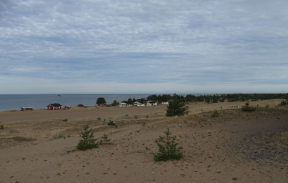
Kalajoki sandbars are a nature destination and tourist center in Kalajoki, a province of Northern Ostrobothnia on the coast of the Gulf of Bothnia. The Kalajoki sandbars are located along Highway 8, about ten kilometers south of the Kalajoki city center. The year-round services of the Kalajoki Sandbreak Tourist Center include routes for skiing and Nordic walking, jogging, equestrian sports, a spa hotel with wellness, health and fitness services, food and entertainment restaurant services, and year-round accommodation and conference services. At the mouth of the Kalajoki estuary is the old market place of the Kalajoki River, around which the village community "Plassi" has been built. Plassi has an old sawmill milieu and Havula Sahakartano, which can be visited in summer time and at other times by appointment.
2.Kalajoki Church
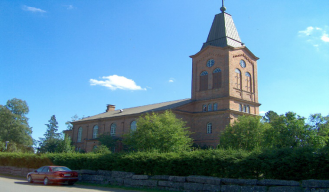
Kalajoki Church was built of uncovered red brick between 1876 and 1879. It was designed by FW Lüchow. At one end of the long church is a tower and at the other an altar, which is a shell in the abscess. It has about 1,300 seats and an area of 988 square meters. Originally, the church was neo-Gothic and three-nave. The church was destroyed by fire on February 16, 1930. The church was rebuilt between 1930 and 1931 and consecrated on February 15, 1931. Renovation drawings of the church were made by WG Palmqvist, when the top of the tower was lowered and the long - shaped ship in the church hall was turned into a concrete barrel vault. Originally, they had folding ceilings and the side ships flat ceilings.
3.Rahja Archipelago
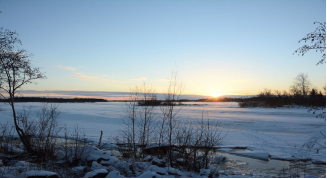
The Rahja archipelago is an archipelago located in the central part of the eastern coast of the Gulf of Bothnia, which spreads to the municipalities of Northern Ostrobothnia and the municipalities of Kalajoki and Kokkola, formerly Lohtaja. The archipelago, with an area of 84 square kilometers, was designated a Natura 2000 site in 1998. The area is managed by Metsähallitus.
The archipelago was born with an uprising, and the uplift has shaped the natural features of the islands. The region is therefore unique in Europe. The islands are home to different archipelago habitats from inland archipelago forests to offshore islets. The area also has a traditional archipelago culture, and the landscape includes fishing villages, flowering meadows and pastures.
六、历史文化
1. 历史
The Kalajoki region was completely under water until the end of the Stone Age, which is why few Stone Age artifacts have been found in the municipality. The most significant discoveries are Kivimaa wide residence Rautio area. The area was inhabited by the Sámi until the 13th and 14th centuries. Later, the area was mainly the wilderness area of the people of Satakunta and Häme.
Permanent settlement began when a few wilderness visitors settled at the mouth of the Kalajoki and Himanganjoki rivers. The oldest villages in the region are Pohjankylä, Eteläkylä and Raumankari, which were probably founded in the 14th and 15th centuries. The main occupations of the population were initially agriculture , fishing and seal hunting . [8] Fish were caught from the largest rivers and the sea.
In the Middle Ages, Kalajoki belonged to the Salo parish. In 1525, the Salo Chapel Parish was formed from Kalajoki. Himanka, on the other hand, first belonged to the administrator of Pietarsaari, from the 1490s to the administrator of Kokkola. In the 1570s, Kalajoki was formed into its own administrative area, which included Alavieska , Ylivieska , Sievi , Reisjärvi , Nivala and Haapajärvi .
Kalajoki and Himanka grew slowly in the 17th century, when the development of the population was particularly affected by the years of strife and wartime. Great hatred also limited the population development of Kalajoki and Himanga. After the Great Wrath, the population began to rise and in the late 18th century the population began to grow strongly. The good traffic position of the Kalajoki and Himanga estuaries led to the bourgeoisie of Kokkola starting to hold markets in these areas. In Kalajoki, the Plass marketplace became an important trading place in the region.
In the Finnish War in Himanga in 1808 there were small skirmishes with the Russians. Wilhelm von Schwerin died in the battle of Kalajoki during the Finnish War. The Kalajoki River was one of the core areas of the revival movement in the Kalajoki Valley in the early 19th century. In 1838–1839, the well-known Kalajoki district was held in the Törnvall House in Pohjankylä, where the awakened were convicted on the basis of a convection poster. A large number of awakened laymen were fined and priests were briefly removed from office. Siltasaarithe relocated district building currently serves as the Kalajoki local history museum.
Kalajoki was founded in 1865. The population of Kalajoki grew steadily for a long time in the 20th century. In 1920 the municipality had 5,780 inhabitants. In 1952 there were 7,085 of them and in 1960 already 7,373 inhabitants. However, the 1960s cut off favorable demographic trends and by 1970 the population had fallen to 6,979. In the 1970s, the population began to grow again. In 1985, Kalajoki had a population of 9,108. Kalajoki became a city at the beginning of 2002.
2. 文化
Today, Kalajoki is known as a tourist municipality. The sandbars of the Kalajoki River have been a nationally known and marketed holiday destination since the 1970s. Kalajoki also continues to have a strong agricultural tradition, with farms still producing grain, potatoes, meat and milk. The metal industry in Kalajoki is driven by the steel of Kalajoki and the port of Rahja, among others.
七、其他信息
Kalajoki has many events and festivals throughout the year. Some of which are the:
·Kalajoki X-Games. The event, organized for the first time in 2007, brings Kalajoki the best in Finland in the field of snowboarding and Newschool. The time of the event is at the beginning of June in Hiekkasärk.
·Kalajoki Autumn Market. Ever since the establishment of the Kokkola city shopping area in 1620, a market has been held in Kalajoki. This market is always held in the autumn at Plass, which is the oldest area in Kalajoki.
·Sandpiper Midsummer. Every year, Kalajoki's Juhannus has gathered people all over Finland to gather on sandy beaches to watch the midnight sun and sunbathe.
八、联系方式
Mayor: Puoskari Jukka
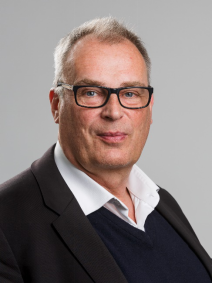
Administrative services: General administration
044 4691 200
jukka.puoskari@kalajoki.fi
Kalajoentie 5, 85100, Kalajoki
